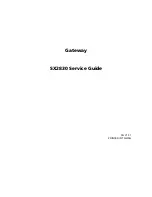
Z-Series Audio Optimization Guide
Z-Series Audio Optimization Guide
Page 8 of 10
Interoperability Now
device, that user is accustomed to simply begin talking. This means that, without
intervention by the Z-Series device, the beginning of that user’s message will be clipped,
and only what the user says after the trunked system finishes acquiring the channel will
be heard. The same is true for any cross-connected users with non-trunked radios, they
will simply press PTT and begin talking. This “clipping of initial syllables in TX audio”
is resolved in the Z-Series device by adding TX audio delay at the unit’s radio interface
to the donor radio for the trunked radio channel. The TX Delay keys up the radio
immediately, but holds up the audio, storing it in a buffer, until enough time has gone by
for a typical channel acquisition time to have elapsed. The trunked radio is then ready to
accept the audio to be transmitted, and the Z-Series device’s audio buffer then begins
spooling it out.
3.4
Receive Delay (RX Audio Delay)
Delay in the RX audio occurs by processing the COR detection immediately while holding the
incoming audio in a buffer and spooling it out after the set delay time. This resolves the
(uncommon) condition for a Radio Channel where the COR indication or detection occurs late
and initial incoming syllables are therefore clipped.
The Z-Series Radio Channel interfaces are designed to prevent this as well as is practical, through
proper design of the various COR Detection algorithms and by including a minimum RX Audio
Delay for VOX and VMR. Additional VOX delay can be added if needed, however it will
increase latency. Prior to adjusting RX Delay, you might try lowering the VOX Threshold,
increasing the radio volume, or decreasing the RX Audio Level setting.
3.5
Audio Levels and Delays for Virtual or Backhaul Channels
In most cases, there are no associated configuration options for RX or TX level settings, or to
change RX or TX audio delays for the JPS RoIP, RTP, and JPS Bridge virtual or backhaul
channels. However, some PTT over Cellular channels feature an RX Gain setting, and TX Delay
and VOX Sensitivity are both configuration settings for SIP. In most instances, modifying the
levels or delays for these channel types is done at the audio input or output channels feeding or
receiving analog audio. Audio on these channel types should be modified following (i.e. after)
optimization of all analog interfaces.
For example, let’s say a pair of RSP-Z2s (or ACU-Z1s) is used to connect radios over IP (RoIP)
that are on opposite sides of the world. If the RX input of each radio is correct, the level received
by the distant radio on the other side of the JPS RoIP link will be correct. If audio is set too low
coming into the RSP-Z2 on the local radio, it will also be too low coming out of the remote
RSP‑Z2.
3.6
VOX Threshold
The VOX threshold may benefit from optimization (either more or less sensitive) due to system
variations or user preferences. More sensitive means less audio level must be detected for the
incoming audio to be declared valid. Less sensitive is the opposite (i.e. more audio must be
detected for the incoming audio to be declared valid). Increased sensitivity makes it more likely
that falsing (declaring the input valid when it is not) will occur; decreased sensitivity increases
the potential that valid speech may be missed. Changes may be desired due to level of static on
the channel, quiet talkers, or desire to never miss any audio, even if some falsing occurs.



























